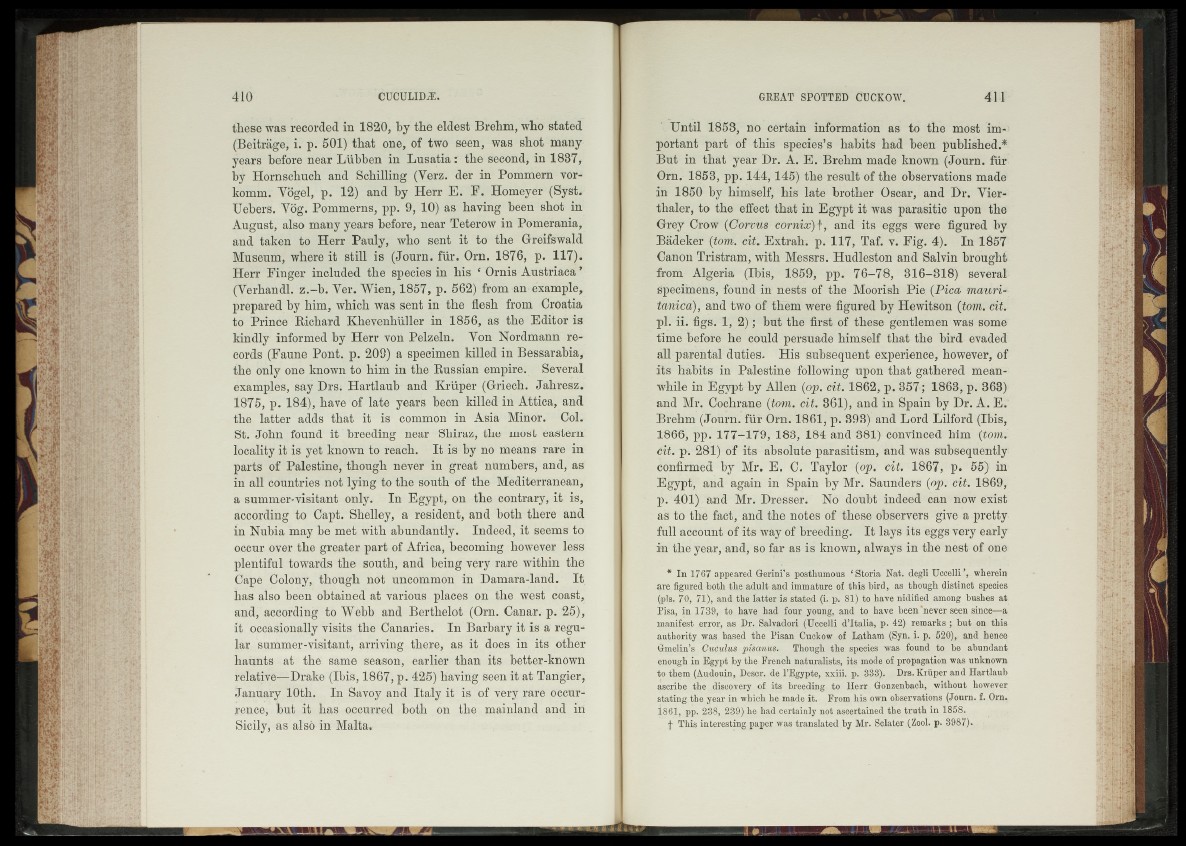
these was recorded in 1820, by the eldest Brehm, who stated
(Beiträge, i. p. 501) that one, of two seen, was shot many
years before near Lübben in Lusatia: the second, in 1837,
by Hornschuch and Schilling (Verz. der in Pommern vorkomm.
Vögel, p. 12) and by Herr E. F. Homeyer (Syst.
Uebers. Vög. Pommerns, pp. 9, 10) as having been shot in
August, also many years before, near Teterow in Pomerania,
and taken to Herr Pauly, who sent it to the Greifswald
Museum, where it still is (Journ. für. Orn. 1876, p. 117).
Herr Finger included the species in his ‘ Ornis Austriaca r
(Verhandl. z.-b. Ver. Wien, 1857, p. 562) from an example,
prepared by him, which was sent in the flesh from Croatia
to Prince Richard Khevenhüller in 1856, as the Editor is
kindly informed by Herr von Pelzeln. Von Nordmann records
(Faune Pont. p. 209) a specimen killed in Bessarabia,
the only one known to him in the Russian empire. Several
examples, say Drs. Hartlaub and Kr'dper (Griech. Jahresz.
1875, p. 184), have of late years been killed in Attica, and
the latter adds that it is common in Asia Minor. Col.
St. John found it breeding near Shiraz, the most eastern
locality it is yet known to reach. It is by no means rare in
parts of Palestine, though never in great numbers, and, as
in all countries not lying to the south of the Mediterranean,
a summer-visitant only. In Egypt, on the contrary, it is,
according to Capt. Shelley, a resident, and both there and
in Nubia may be met with abundantly. Indeed, it seems to
occur over the greater part of Africa, becoming however less
plentiful towards the south, and being very rare within the
Cape Colony, though not uncommon in Damara-land. It
has also been obtained at various places on the west coast,
and, according to Webb and Berthelot (Orn. Canar. p. 25),
it occasionally visits the Canaries. In Barbary it is a regular
summer-visitant, arriving there, as it does in its other
haunts at the same season, earlier than its better-known
relative—Drake (Ibis, 1867, p. 425) having seen it at Tangier,
January 10th. In Savoy and Italy it is of very rare occurrence,
but it has occurred both on the mainland and in
Sicily, as also in Malta.
Until 1853, no certain information as to the most im-
portant part of this species’s habits had been published.*
But in that year Dr. A. E. Brehm made known (Journ. für
Orn. 1853, pp. 144,145) the result of the observations made
in 1850 by himself, his late brother Oscar, and Dr. Vier-
thaler, to the effect that in Egypt it was parasitic upon the
Grey Crow (Corvus cornix)\, and its eggs were figured by
Bädeker (tom. cit. Extrah. p. 117, Taf. v. Fig. 4). In 1857
Canon Tristram, with Messrs. Hudleston and Salvin brought
from Algeria (Ibis, 1859, pp. 76-78, 316-318) several
specimens, found in nests of the Moorish Pie (Pica mauri-
tanica), and two of them were figured by Hewitson (tom. cit.
pi. ii. figs. 1 , 2 ); but the first of these gentlemen was some
time before he could persuade himself that the bird evaded
all parental duties. His subsequent experience, however, of
its habits in Palestine following upon that gathered meanwhile
in Egypt by Allen (op. cit. 1862, p. 357; 1863, p. 363)
and Mr. Cochrane (tom. cit. 361), and in Spain by Dr. A. E.
Brehm (Journ. für Orn. 1861, p. 393) and Lord Lilford (Ibis,
1866, pp. 177-179, 183, 184 and 381) convinced him (tom.
cit. p. 281) of its absolute parasitism, and was subsequently
confirmed by Mr. E. C. Taylor (op. cit. 1867, p. 55) in
Egypt, and again in Spain by Mr. Saunders (op. cit. 1869,
p. 401) and Mr* Dresser, No doubt indeed can now exist
as to the fact, and the notes of these observers give a pretty
full account of its way of breeding. It lays its eggs very early
in the year, and, so far as is known, always in the nest of one
* In 1767 appeared Gerini’s posthumous ‘ Storia Nat. degli Uccelli’, wherein
are figured both the adult and immature of this bird, as though distinct species
(pis. 70, 71), and the latter is stated (i. p. 81) to have nidified among bushes at
Pisa, in 1739, to have had four young, and to have been‘never seen since—a
manifest error, as Dr. Salvadori (Uccelli d’ltalia, p. 42) remarks ; but on this
authority was based the Pisan Cuckow of Latham (Syn. i. p. 520), and hence
Gmelin’s Cuculus pisanus. Though the species was found to be abundant
enough in Egypt by the French naturalists, its mode of propagation was unknown
to them (Audouin, Descr. de l’Egypte, xxiii. p. 333). Drs. Kriiper and Hartlaub
ascribe the discovery of its breeding to Herr Gonzenbach, without however
stating the year in which he made it. From his own observations (Journ. f. Om.
1861, pp. 238, 239) he had certainly not ascertained the truth in 1858.
f This interesting paper was translated by Mr. Sclater (Zool. p. 3987).